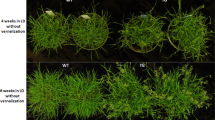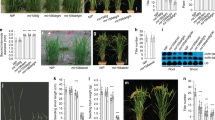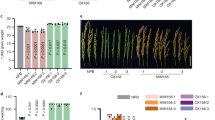Abstract
Strategies to increase rice productivity to meet the global demand have been the main concern of breeders around the world. Although a growing number of functional genes related to crop yield have been characterized, our understanding of its associated regulatory pathways is limited. Using rice as a model, we find that blocking miR396 greatly increases grain yield by modulating development of auxiliary branches and spikelets through direct induction of the growth regulating factor 6 (OsGRF6) gene. The upregulation of OsGRF6 results in the coordinated activation of several immediate downstream biological clades, including auxin (IAA) biosynthesis, auxin response factors, and branch and spikelet development-related transcription factors. This study describes a conserved microRNA (miRNA)-dependent regulatory module that integrates inflorescence development, auxin biosynthesis and signalling pathways, and could potentially be used in engineering high-yield crop plants.
This is a preview of subscription content, access via your institution
Access options
Subscribe to this journal
Receive 12 digital issues and online access to articles
$119.00 per year
only $9.92 per issue
Buy this article
- Purchase on Springer Link
- Instant access to full article PDF
Prices may be subject to local taxes which are calculated during checkout





Similar content being viewed by others
References
McClung, C. R. Making hunger yield. Science 344, 699–700 (2014).
Xing, Y. & Zhang, Q. Genetic and molecular bases of rice yield. Annu. Rev. Plant Biol. 61, 421–442 (2010).
Sreenivasulu, N. & Schnurbusch, T. A genetic playground for enhancing grain number in cereals. Trends Plant Sci. 17, 91–101 (2012).
Jones-Rhoades, M. W., Bartel, D. P. & Bartel, B. MicroRNAs and their regulatory roles in plants. Annu. Rev. Plant Biol. 57, 19–53 (2006).
He, L. & Hannon, G. J. MicroRNAs: small RNAs with a big role in gene regulation. Nature Rev. Genet. 5, 522–531 (2004).
Chen, X. A microRNA as a translational repressor of APETALA2 in Arabidopsis flower development. Science 303, 2022–2025 (2004).
Mallory, A. C. & Vaucheret, H. Functions of microRNAs and related small RNAs in plants. Nature Genet. 38, S31–S36 (2006).
Navarro, L. et al. A plant miRNA contributes to antibacterial resistance by repressing auxin signaling. Science 312, 436–439 (2006).
Jiao, Y. et al. Regulation of OsSPL14 by OsmiR156 defines ideal plant architecture in rice. Nature Genet. 42, 541–544 (2010).
Lu, Z. et al. Genome-wide binding analysis of the transcription activator IDEAL PLANT ARCHITECTURE1 reveals a complex network regulating rice plant architecture. Plant Cell 25, 3743–3759 (2013).
Miura, K. et al. OsSPL14 promotes panicle branching and higher grain productivity in rice. Nature Genet. 42, 545–549 (2010).
Zhang, Y.-C. et al. Overexpression of microRNA OsmiR397 improves rice yield by increasing grain size and promoting panicle branching. Nature Biotech. 31, 848–852 (2013).
Yoshida, A. et al. TAWAWA1, a regulator of rice inflorescence architecture, functions through the suppression of meristem phase transition. Proc. Natl Acad. Sci. USA 110, 767–772 (2012).
Yoshida, A., Ohmori, Y., Kitano, H., Taguchi-Shiobara, F. & Hirano, H.-Y. Aberrant spikelet and panicle1, encoding a TOPLESS-related transcriptional co-repressor, is involved in the regulation of meristem fate in rice. Plant J. 70, 327–339 (2012).
Ikeda, K., Ito, M., Nagasawa, N., Kyozuka, J. & Nagato, Y. Rice ABERRANT PANICLE ORGANIZATION 1, encoding an F-box protein, regulates meristem fate. Plant J. 51, 1030–1040 (2007).
Oikawa, T. & Kyozuka, J. Two-step regulation of LAX PANICLE1 protein accumulation in axillary meristem formation in rice. Plant Cell 21, 1095–1108 (2009).
Bazin, J. et al. MiR396 affects mycorrhization and root meristem activity in the legume Medicago truncatula. Plant J. 74, 920–934 (2013).
Rodriguez, R. E. et al. Control of cell proliferation in Arabidopsis thaliana by microRNA miR396. Development 137, 103–112 (2010).
Liu, H. et al. OsmiR396d-regulated OsGRFs function in floral organogenesis in rice through binding to their targets OsJMJ706 and OsCR4. Plant Physiol. 165, 160–174 (2014).
Debernardi, J. M., Rodriguez, R. E., Mecchia, M. A. & Palatnik, J. F. Functional specialization of the plant miR396 regulatory network through distinct microRNA–target interactions. PLoS Genet. 8, e1002419 (2012).
Kyozuka, J., Tokunaga, H. & Yoshida, A. Control of grass inflorescence form by the fine-tuning of meristem phase change. Curr. Opin. Plant Biol. 17, 110–115 (2014).
Feng, J., Liu, T., Qin, B., Zhang, Y. & Liu, X. S. Identifying ChIP-seq enrichment using MACS. Nat. Protoc. 7, 1728–1740 (2012).
Gao, X. et al. The SEPALLATA-like gene OsMADS34 is required for rice inflorescence and spikelet development. Plant Physiol. 153, 728–740 (2010).
Huang da, W., Sherman, B. T. & Lempicki, R. A. Systematic and integrative analysis of large gene lists using DAVID bioinformatics resources. Nature Protoc. 4, 44–57 (2009).
Peer, W. A. From perception to attenuation: auxin signalling and responses. Curr. Opin. Plant Biol. 16, 561–568 (2013).
Gallavotti, A. et al. Sparse inflorescence1 encodes a monocot-specific YUCCA-like gene required for vegetative and reproductive development in maize. Proc. Natl Acad. Sci. 105, 15196–15201 (2008).
Tanaka, W., Pautler, M., Jackson, D. & Hirano, H.-Y. Grass meristems II: inflorescence architecture, flower development and meristem fate. Plant Cell Physiol. 54, 313–324 (2013).
Zhang, D. & Yuan, Z. Molecular control of grass inflorescence development. Annu. Rev. Plant Biol. 65, 553–578 (2014).
Barazesh, S. & McSteen, P. Hormonal control of grass inflorescence development. Trends Plant Sci. 13, 656–662 (2008).
Gallavotti, A. The role of auxin in shaping shoot architecture. J. Exp. Bot. 64, 2593–2608 (2013).
Yamamoto, Y., Kamiya, N., Morinaka, Y., Matsuoka, M. & Sazuka, T. Auxin biosynthesis by the YUCCA genes in rice. Plant Physiol. 143, 1362–1371 (2007).
Nelissen, H. et al. Dynamic changes in ANGUSTIFOLIA3 complex composition reveal a growth regulatory mechanism in the maize leaf. Plant Cell 27, 1605–1619 (2015).
Kim, J. H. & Tsukaya, H. Regulation of plant growth and development by the GROWTH-REGULATING FACTOR and GRF-INTERACTING FACTOR duo. J. Exp. Bot. 66, 6093–6107 (2015).
Karimi, M., Inzé, D. & Depicker, A. GATEWAY™ vectors for Agrobacterium-mediated plant transformation. Trends Plant Sci. 7, 193–195 (2002).
Franco-Zorrilla, J. M. et al. Target mimicry provides a new mechanism for regulation of microRNA activity. Nature Genet. 39, 1033–1037 (2007).
Hiei, Y., Ohta, S., Komari, T. & Kumashiro, T. Efficient transformation of rice (Oryza sativa L.) mediated by Agrobacterium and sequence analysis of the boundaries of the T-DNA. Plant J. 6, 271–282 (1994).
Javelle, M. & Timmermans, M. C. P. In situ localization of small RNAs in plants by using LNA probes. Nature Protoc. 7, 533–541 (2012).
Ouyang, S. et al. The TIGR Rice Genome Annotation Resource: improvements and new features. Nucleic Acids Res. 35, D883–D887 (2007).
Saleh, A., Alvarez-Venegas, R. & Avramova, Z. An efficient chromatin immunoprecipitation (ChIP) protocol for studying histone modifications in Arabidopsis plants. Nature Protoc. 3, 1018–1025 (2008).
Langmead, B., Trapnell, C., Pop, M. & Salzberg, S. L. Ultrafast and memory-efficient alignment of short DNA sequences to the human genome. Genome Biol. 10, R25 (2009).
Zhang, Y. et al. Model-based Analysis of ChIP-Seq (MACS). Genome Biol. 9, R137 (2008).
Bailey, T. L. DREME: motif discovery in transcription factor ChIP-seq data. Bioinformatics 27, 1653–1659 (2011).
Wang, K. et al. Using FAM labeled DNA oligos to do RNA electrophoretic mobility shift assay. Mol. Biol. Rep. 37, 2871–2875 (2010).
Hellman, L. M. & Fried, M. G. Electrophoretic mobility shift assay (EMSA) for detecting protein-nucleic acid interactions. Nature Protoc. 2, 1849–1861 (2007).
Chen, W. et al. A novel integrated method for large-scale detection, identification, and quantification of widely targeted metabolites: application in the study of rice metabolomics. Mol. Plant 6, 1769–1780 (2013).
Acknowledgements
This research was partly supported by the National Transgenic Research and Development Program (2011ZX08001-004), the 863 Program (2012AA10A303) and the National Science Foundation (31370363) of China. We would like to thank Xuefeng Chen, Yan Zhou, Bo Zhong and Jing Yao (College of Life Science, Wuhan University) for their critical reading and advice during the preparation of this report. We also thank Yu Zhou and Pinji Lei (College of Life Science, Wuhan University) for providing assistance in the bioinformatic analysis.
Author information
Authors and Affiliations
Contributions
F.G. performed in situ hybridization, SEM, EMSA and phenotypic observation. K.W. conducted microArray, CHIP-seq and RNA-seq analysis. Y.L. performed promoter analysis. Y.C. performed overexpression genesis. P.C. performed qPCR and developed the GRF transgene. Z.S. conducted the construction of the MIM396 vector. J.L. performed hormone analysis. D.J. performed gel blotting of miRNA in the hybrids. F.F. and Y.Z. designed and performed the field experiments. S.L. designed the experiments and wrote the paper.
Corresponding author
Ethics declarations
Competing interests
The authors declare no competing financial interests.
Supplementary information
Rights and permissions
About this article
Cite this article
Gao, F., Wang, K., Liu, Y. et al. Blocking miR396 increases rice yield by shaping inflorescence architecture. Nature Plants 2, 15196 (2016). https://doi.org/10.1038/nplants.2015.196
Received:
Accepted:
Published:
DOI: https://doi.org/10.1038/nplants.2015.196
This article is cited by
-
OsmiR159 Modulate BPH Resistance Through Regulating G-Protein γ Subunit GS3 Gene in Rice
Rice (2023)
-
Genome-wide analysis of growth-regulating factor genes in grape (Vitis vinifera L.): identification, characterization and their responsive expression to osmotic stress
Plant Cell Reports (2023)
-
OsUGE1 is directly targeted by OsGRF6 to regulate root hair length in rice
Theoretical and Applied Genetics (2023)
-
Identification and exploration of the GRF and GIF families in maize and foxtail millet
Physiology and Molecular Biology of Plants (2022)
-
Fine mapping of the reduced height gene Rht22 in tetraploid wheat landrace Jianyangailanmai (Triticum turgidum L.)
Theoretical and Applied Genetics (2022)



